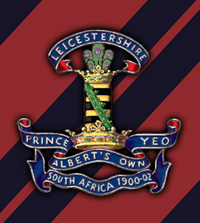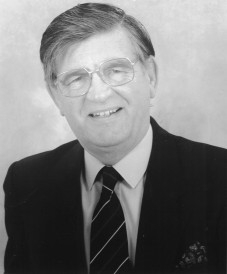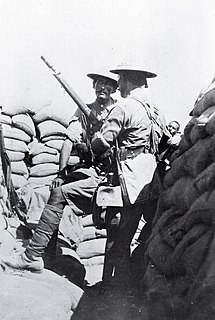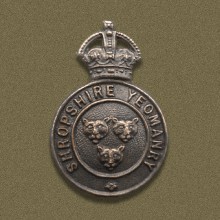A division is a large military unit or formation, usually consisting of between 6,000 and 25,000 soldiers.

The 1st Cavalry Division was a regular Division of the British Army during the First World War where it fought on the Western Front. During the Second World War it was a first line formation, formed from Yeomanry Regiments. It fought in the Middle East before being converted to the 10th Armoured Division.

The Leicestershire Yeomanry was a yeomanry regiment of the British Army, first raised in 1794 and again in 1803, which provided cavalry and mounted infantry in the Second Boer War and the First World War and provided two field artillery regiments of the Royal Artillery in the Second World War, before being amalgamated with the Derbyshire Yeomanry into forming the Leicestershire and Derbyshire Yeomanry in 1957. The regiment's lineage is currently perpetuated by E Squadron of the Royal Yeomanry.

The Derbyshire Yeomanry was a yeomanry regiment of the British Army, first raised in 1794, which served as a cavalry regiment and dismounted infantry regiment in the First World War and provided two reconnaissance regiments in the Second World War, before being amalgamated with the Leicestershire Yeomanry to form the Leicestershire and Derbyshire Yeomanry in 1957.

The Warwickshire Yeomanry was a yeomanry regiment of the British Army, first raised in 1794, which served as cavalry and machine gunners in the First World War and as a cavalry and an armoured regiment in the Second World War, before being amalgamated into the Queen's Own Warwickshire and Worcestershire Yeomanry in 1956. The lineage is maintained by B Squadron, part of The Royal Yeomanry.

The Lanarkshire Yeomanry was a yeomanry regiment of the British Army, first raised in 1819, which served as a dismounted infantry regiment in the First World War and provided two field artillery regiments in the Second World War, before being amalgamated into The Queen's Own Lowland Yeomanry in 1956. Its lineage was revived by B Squadron, the Scottish Yeomanry in 1992 until that unit was disbanded in 1999.

Michael John William Chappell BEM, better known as Mike Chappell, was an English military historian and illustrator of military books.

The Northumberland Hussars was a Yeomanry regiment of the British Army, transferred to the Royal Artillery for the duration of the Second World War. It was disbanded as an independent Territorial Army unit in 1967, a time when the strength of the Territorial Army was greatly reduced. The regiment's name lives on in the title of the command and support squadron of the Queen's Own Yeomanry (QOY), a Formation Reconnaissance Regiment based in Newcastle upon Tyne.

The Cheshire Yeomanry was a yeomanry regiment that can trace its history back to 1797 when Sir John Leicester of Tabley raised a county regiment of light cavalry in response to the growing fears of invasion from Napoleonic France. Its lineage is maintained by C Squadron, the Queen's Own Yeomanry.

The 7th (Meerut) Division was an infantry division of the British Indian Army that saw active service during World War I.
The 3rd (Lahore) Division was an infantry division of the British Indian Army, first organised in 1852. It saw service during World War I as part of the Indian Corps in France before being moved to the Middle East where it fought against troops of the Ottoman Empire.

The Shropshire Yeomanry was a yeomanry regiment of the British Army, first raised in 1795, which served as a cavalry and dismounted infantry regiment in the First World War and as a cavalry and an artillery regiment in the Second World War. It was then amalgamated with the Shropshire Royal Horse Artillery.

The North Somerset Yeomanry was a part-time cavalry regiment of the British Army from 1798 to 1967. It maintained order in Somerset in the days before organised police forces, and supplied volunteers to fight in the Second Boer War. It served on the Western Front in the First World War. At the outbreak of the Second World War, it continued to operate in the mounted role and then as a specialist signals unit. Postwar it joined the Royal Armoured Corps and later became infantry. Its lineage today is maintained by 93 Squadron 39 (Skinners) Signal Regiment.

The South Nottinghamshire Hussars is a unit of the British Army formed as volunteer cavalry in 1794. Converted to artillery in 1922, it presently forms part of 103 Regiment, Royal Artillery.

The Westmorland and Cumberland Yeomanry was a Yeomanry Cavalry regiment of the British Army with its origins in 1798. The regiment provided troops for the Imperial Yeomanry during the Second Boer War and served on the Western Front in World War I, latterly as infantry. The regiment converted to artillery in 1920 and served as such in the early years of World War II, before becoming part of the Chindits in Burma. Postwar it served as a gunner regiment until 1971 when the title disappeared.
The Queen's Own Royal Glasgow Yeomanry was a yeomanry regiment of the British Army that can trace their formation back to 1796. It saw action in the Second Boer War, the First World War and the Second World War. It amalgamated with the Lanarkshire Yeomanry and the 1st/2nd Lothians and Border Horse to form the Queen's Own Lowland Yeomanry in 1956. Its lineage was revived by B Squadron, the Scottish Yeomanry in 1992 until that unit was disbanded in 1999.

This is the order of battle for the Battle of the Somme. The Battle of the Somme was an offensive fought on the Western Front during World War I from 1 July to 18 November 1916 as one of the greatest engagements of the war. It was fought between French, British and Dominion forces and the German Empire in the Somme River valley and vicinity in northern France.
The 63rd Division of the British Army was a second-line Territorial Force division, formed in 1914, which served on home defence duties during the First World War. The division was formed as a duplicate of the 50th (Northumbrian) Division in 1914, composed primarily of soldiers recruited in north-eastern England. It remained on home defence and training duties in the north-east and east of England until 1916, when it was disbanded. Several of its constituent units would later serve overseas, deployed for support and garrison duties in almost every theatre of the war.
The 65th Division of the British Army was a second-line Territorial Force division, formed in 1914, which served on home defence duties during the First World War.
The Warwickshire Royal Horse Artillery was a Territorial Force Royal Horse Artillery battery that was formed in Warwickshire in 1908. It was the first Territorial Force artillery unit to go overseas on active service, spending the whole of the First World War on the Western Front, mostly with 1st Cavalry Division and 29th Division. A second line battery, 2/1st Warwickshire RHA, also served on the Western Front in 1917 and 1918 as part of an Army Field Artillery Brigade. Post-war it was reconstituted as a Royal Field Artillery battery.














